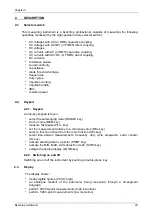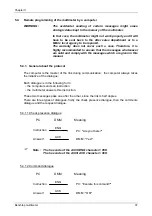
Chapter II
Benchtop multimeter
27
∗
Before changing functions, disconnect the test leads from the circuit under test.
∗
When performing current measurements, never change of range, do not connect
or disconnect leads without first isolating the current. If you do, there is a risk of
generating surge currents which can blow the fuses or damage the instrument.
∗
In TV repair work, or when carrying out measurements on power switching circuits,
remember that high amplitude voltage pulses at the test points can damage the
multimeter. Use of an type TV filter will attenuate any such pulses.
∗
Never perform resistance measurements on live circuits.
1.1.3. Symbols
W arning : Refer to the user's m anual.
D a ng e r, h ig h v oltage : R isk of elec tr ic sh oc k
E arth term ina l
1.1.4. Opening the instrument
∗
Before opening the instrument, always disconnect from all sources of electric
current and make sure not to be loaded with static electricity, which may destroy
internal components.
∗
Fuses must be replaced with fuses of the same rating and type.
∗
Any adjustment, maintenance or repair work carried out on the multimeter while it
is live should be carried out only by appropriately qualified personnel. A
"qualified person" is one who is familiar with the installation, construction and
operation of the equipment and the hazards involved. He is trained and
authorized to energize, de-energize circuits and equipment in accordance with
established practices.
∗
When the instrument is open, remember that some internal capacitors can retain
a dangerous potential even after the instrument is powered down.
∗
If any faults or abnormalities are observed, take the instrument out of service and
ensure that it cannot be used until it has been checked out.
1.2. Protection
devices
ASYC II serie instruments are fitted with various protection devices :
∗
Varistor protection for limiting transients of over 1100 V at the V
Ω
terminal,
particularly 6 kV pulse streams as defined in French standard NFC 41-102.
∗
A PTC (Positive Temperature Coefficient) resistor protects against permanent
overvoltages of up to 600
V during resistance, capacitance and diode test
measurements. This protection is reset automatically after overload.
1.3. Safety
devices
∗
When measuring voltages above 24 V, the sign blinks
on the display.
∗
If the maximum range is repeatedly exceeded, an intermittent audible signal indicates
the risk of electric shock.
















































